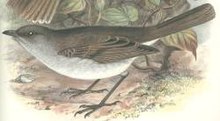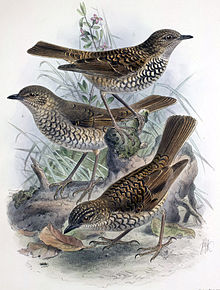Olomaʻo
| Olomaʻo | |
|---|---|

| |
| Scientific classification | |
| Domain: | Eukaryota |
| Kingdom: | Animalia |
| Phylum: | Chordata |
| Class: | Aves |
| Order: | Passeriformes |
| Family: | Turdidae |
| Genus: | Myadestes |
| Species: | M. lanaiensis
|
| Binomial name | |
| Myadestes lanaiensis (Wilson, SB, 1891)
| |

| |
The olomaʻo (Myadestes lanaiensis) is a small, dark solitaire endemic to Maui, Lānaʻi and Molokaʻi in the Hawaiian Islands. It is listed as Critically Endangered.[1]
The extinct ʻāmaui, either a subspecies of M. lanaiensis[2] or a distinct species (as M. woahensis),[3] was endemic to Oʻahu.
Description
[edit]It grows up to 7 inches in length. The male and female of the species look similar. It is dark brown above and gray below with blackish legs.

Call
[edit]Its song consists of a complex melody of flute-like notes, liquid warbles, and gurgling whistles. The call is a catlike rasp, with an alternate high pitched note similar to a police whistle.
Behavior and diet
[edit]It occurs in densely vegetated gulches, frequenting the understory where it often perches motionless in a hunched posture. Like other native Hawaiian thrushes, it quivers its wings and feeds primarily on fruit and insects.
Conservation
[edit]The olomaʻo is still classified as Critically Endangered due to the possibility that an extremely small population or individuals may still exist. The last definitive sighting occurred on Oahu in the 1850s, on Lanai in 1933, and on Molokaʻi in 1980 in the Kamakou Preserve.[1] In the late 19th century, it was considered common to abundant on the Maui, Lanai, and Molokaʻi, but land clearing, including the establishment and subsequent development of Lānaʻi City, and avian malaria brought on by introduced mosquitoes decimated the birds. Introduced animals such as feral pigs (which create pools from their wallows for breeding mosquitoes) also aided in its demise.
Taxonomy
[edit]It is closely related to the other species of Hawaiian thrushes, the puaiohi (M. palmeri), ʻōmaʻo (M. obscurus), and the probably extinct kāmaʻo (M. myadestinus). Maui birds may have constituted a separate subspecies or race, but became extinct before any studies could be performed. Three subspecies are recognized:
- M. l. woahensis - ʻāmaui
- M. l. lanaiensis - Lānaʻi thrush
- M. l. rutha - Molokaʻi thrush
References
[edit]- ^ a b c BirdLife International (2019). "Myadestes lanaiensis". IUCN Red List of Threatened Species. 2019: e.T22708574A155254449. doi:10.2305/IUCN.UK.2019-3.RLTS.T22708574A155254449.en. Retrieved 12 November 2021.
- ^ "Thrushes – IOC World Bird List". Retrieved 2021-07-29.
- ^ BirdLife International (2017). "Myadestes woahensis". IUCN Red List of Threatened Species. 2017: e.T22708564A111775767. doi:10.2305/IUCN.UK.2017-1.RLTS.T22708564A111775767.en. Retrieved 17 December 2022.
External links
[edit]- Species factsheet - BirdLife International
- 3D view of specimen RMNH 110.026 at Naturalis, Leiden (requires QuickTime browser plugin)
Text is available under the CC BY-SA 4.0 license; additional terms may apply.
Images, videos and audio are available under their respective licenses.

